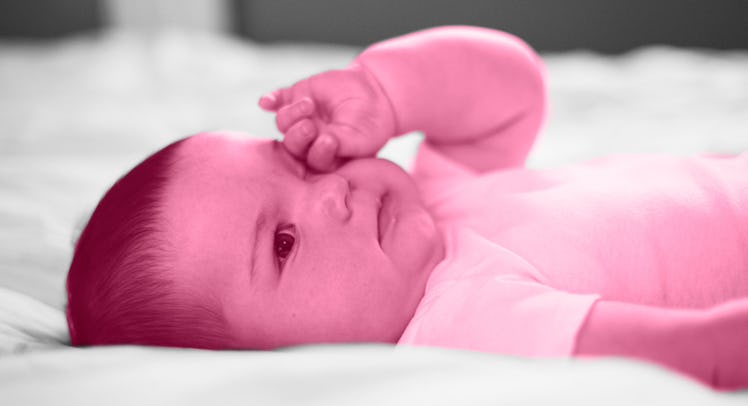How to Treat Pink Eye in Babies and Not Get It Yourself
There is a surefire way to recognize pink eye and babies, but there are several remedies. Some work. Some do not.

When babies and toddlers get pink eye, the symptoms make themselves known almost immediately. Pink eye, also known as conjunctivitis, comes in two forms that can affect children: viral and bacterial. But regardless of what’s causing pink eye in infants, the condition is made apparent by eye irritation and the presence of goop. Lots and lots of goop.
“Basically, any sort of discharge along the eyelashes could be concerning for pink eye,” says Dr. Aishwarya Deenadayalu of Metropolitan Pediatrics in Portland, Oregon. “It’s yellowish-green most commonly … thick discharge that crusts the eye shut.”
How to Diagnose and Treat Pink Eye
- Look for ooze that seals the eyes shut, itchiness, and swollen eyelids
- Make sure to keep the kid away from school
- Wash hands thoroughly and change pillows regularly
- Use antibacterial eye-drops
- Keep the child comfortable and try not to wipe their eyes too much
The most frequent form of pink eye is actually viral, though it’s often treated with antibacterial eye drops or ointments as a precautionary measure. In its viral form, it can take 2 to 3 days to clear up and become non-contagious. The bacterial form lasts longer — five days or so in most cases — but becomes non-contagious within 24 hours of administering antibacterial drugs. And while the myth that it’s caused by getting fecal matter in the eye seems unfounded (it certainly doesn’t help), the actual causes can range from everything from respiratory viruses in the sinuses to herpes.
Regardless of the cause, the signs are pretty clear: ooze that seals the eyes shut and resembles green boogers that colonize on the eyelashes; swollen eyelids and itching.
“It’s kind of a deal-breaker for parents who need to work and their kid gets kicked out of school. It kind of changes your life for a while,” says Deenadayalu. “If anyone touches the discharge, it’s very contagious. And if kids touch their eye, they’re going to touch something else.”
Once the symptoms are present, parents are strongly advised to call a doctor, as pink eye treatment for babies is pretty standard. In all likelihood, whether the infection is viral or bacterial, the pediatrician will prescribe antibacterial pink eye drops or ointments. After that, it’s a waiting game. There are no real proven home remedies or over the counter medications for an infection like pink eye. If it’s viral, the kid just needs to ride it out and let their body do the heavy lifting. If it’s bacterial, the antibiotics do their work. All a parent can do is apply a warm compress to ease the discomfort and wipe those nasty boogers off the eye.
“Just keep the child comfortable,” says Deenadayalu, adding that a parent shouldn’t be constantly swabbing the infected eye. “Over-wiping is just going to renew it, and you’re going to have to wash your hands again.”
Due to the highly contagious nature of pink eye, constant hand-washing is essential for the duration of the affliction, especially with babies and toddlers who won’t know not to touch their eyes. Every time the child’s face is touched, a parent should scrub their hands thoroughly. Sheets should be washed, and pillowcases should be changed regularly. Drinks shouldn’t be shared. No exceptions.
“Because it is so contagious, especially the viral kind, we advise really good hand-washing,” Deenadayalu. “Taking care of a kid with pink eye, a parent needs to be super mindful of that.”